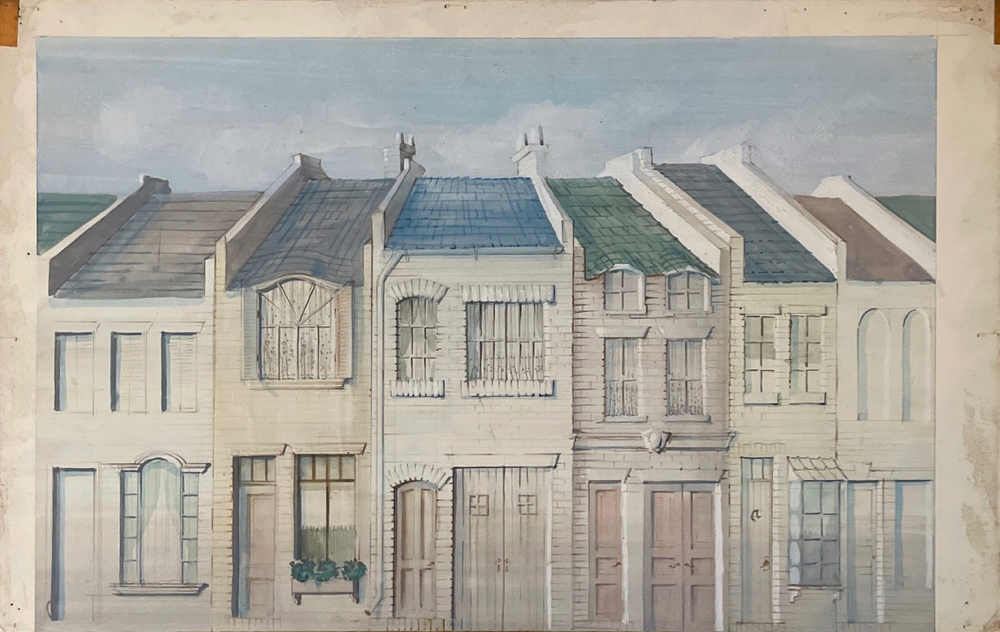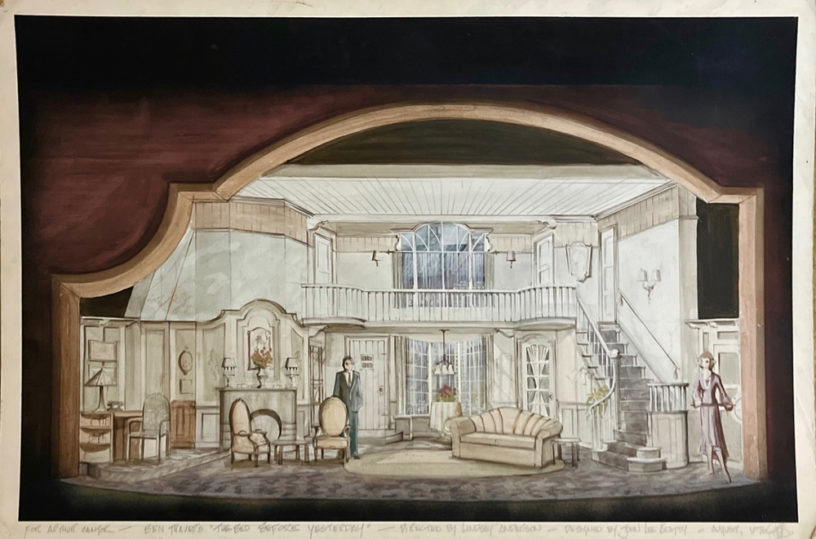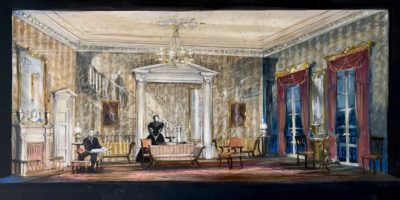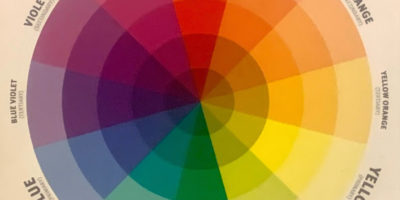I was alone on the night train to Wilmington, Delaware, with a Louis XV side chair. I had snuck it on in the confusion of boarding in Penn Station, and kept changing the carriage vestibules I hid it in. The old local trains had no alcoves for storage. It was a cold, foggy night. The swaying car barely had light or heat at that time of day. The conductor caught me repositioning the chair once again and wanted to throw me, and especially the chair, off at the next station. I told him I just had to get it to Wilmington that night. There was a theatrical emergency: Carol Channing’s knees opened a little too wide for audience comfort sitting on any chair that was too low and the director was screaming at me (long distance) to fix this problem. The Louis XV chair seat was high enough for the Carol challenge, but there was no transportation for the chair, no help in getting it to the theater. The props were ultimately the set designer’s responsibility, as was making Carol Channing look good. So there I was on the train to Wilmington.
Enlarge

ORIGINAL SKETCH BY JOHN LEE BEATTY
Plays had tryouts in Wilmington, Delaware. One stayed at the Dupont Hotel and the Dupont Theater was in the hotel building as well, so the small band of actors and company were all slammed together, isolated in a world of its own. It was rather like a trip to another country.
Wilmington Delaware in the mid-seventies seemed to have been lost in a time warp. Soon Broadway plays wouldn’t be trying out there anymore at all, and already one couldn’t nail into the stage floor because devoid of shows, the historical theater stage had become more useful in downtime as a shinily shellacked basketball court.
I was a young, relatively inexperienced designer, but couldn’t help noticing during the ‘put-in’ of the set that portions of the installation crew were missing for quite some time. I asked an older stagehand and he said the head carpenter was ‘out buying hardware.’ The third time I asked he popped his eyes out and said he was “OUT BUYING HARDWARE.” “Oh,” I replied. Until I learned the secret language of backstage I didn’t know that code meant that someone was at the bar. I learned that day. I went out in the Wilmington streets methodically walking in a spiral making larger and larger circles until I found the head carpenter in a bar, maybe on my fifth try. I pointed out that the scenery wasn’t quite finished being erected, and after another drink, he rather cheerfully came back to the theater to finish the job.
The real foreign language phenomenon was provided by Miss Channing herself. As in a trip to a foreign country, who of us doesn’t pick up a few words and inflections? Well, by the end of two weeks or so, we all spoke like Carol. We did not want to speak like Carol, but those unmistakeable inflections just seeped in. At two and a half weeks of full Carol immersion, we really didn’t want to speak like Carol Channing. Yet still we did.
Miss Channing’s first sweeping star entrance into the theater hotel, long limbed and tall, floor length winter white coat trimmed in white fur with a matching shako hat, was witnessed by the theater janitor, who was clearly a recent immigrant from Puerto Rico with a deep accent, “Is that man or woman?” he questioned, leaning on his mop. The quick thinking show supervisor in his slightly too mellifluous voice replied evenly: “Why that’s Carol Channing.” I’m not sure the janitor was completely satisfied by that answer. But Carol had certainly made a vivid impression.
For the first few weeks of rehearsal in New York, Carol really, really tried serious dramatic acting. She was a quite intelligent woman, but prone to great insecurity. Even going up and down a step was a cause for much self-examination, as her long legs could make her look awkward. I eliminated one platform from the design which made her more comfortable. She said it had made her feel like she was in an old Ethel Merman musical.
When frustrated with a particular predicament, I heard her seriously ask herself “What would the Lunts have done?” in her Dolly Levi voice. Her enormous success in Hello Dolly had made her a press favorite. Carol was now risking all by taking on a hit London play for Broadway. She was to play a sexually repressed, conservative English widow. It was to be a change of image for her. Yet in week three of rehearsal, she showed up in a bright red sailor suit with matching red Breton hat, colorfully made up to meet the press in her ‘full Carol’ mode. We never really got her back. The long strides, the baritone giggle, the pop eyes that connected her to everyone in the auditorium had returned, the signature Carol-isms that it seemed to me she felt were the basis of her stardom.
Onstage at the Dupont, the ingenue was supposedly fired for repeatedly upstaging Carol. The ingenue opined that “Carol could not be upstaged by an elephant,” but that she was more than happy to go home to L. A. A substitute was quickly found. One troubled play I worked on had a different ingenue at each tryout stop along the way, so this was not an unusual tryout practice. I was unprepared, however, when one of the leading gentlemen started crying mid-sentence when talking to me. It seemed things were not going well.
At an afternoon rehearsal, when a prop man in the wings missed his cue for Carol’s ‘hand-off’ of a Royal Doulton tea service, Carol just dropped it all and let it crash to the floor, and we all learned a lesson about being prepared for her at all times. More Royal Doulton was sent for.
Carol conceived the role as a redhead. Oddly, she thought it appropriate for a conservative British widow. One of Carol’s ‘issues’ was the use of natural products (her luggage contained mysterious tupperware containers of natural food) but the vegetable-dyed red wig wasn’t very stable, and she often pulled stray red hairs out of her mouth during other actors’ lines. As I am a redhead, she tried to copy my eyelashes for authenticity, and hung on my every word, or at least eye blink, but finally announced to one and all that I had no lashes at all, so she reverted to her dark Dolly lashes. She did know herself however, and when asked what hat the conservative widow would wear, answered “A toque. A large Toque. Like Queen Mary.” The costume designer and director felt that the enormity of an over-sized birthday cake-like toque missed the mark for conservative matron. Carol reassured, “Don’t worry, on Me, a toque looks conservative!” She was, in this particular case, quite correct.
There was a staircase on the set leading to an upper bedroom, but Carol refused to climb it to end the first act climax until more lighting instruments were acquired to light her on her way. She said she missed her Dolly follow spots in this, her first play after that milestone musical, saying they made her feel so wonderfully warm. The additional lights arrived from New York as soon as possible and Carol adhered to the plot of the play once again.
Enlarge

ORIGINAL SKETCH BY JOHN LEE BEATTY
My train-weary Louis XV chair which I walked up from the station, was deposited onstage by the touring prop man, and I pulled an extra prop lap robe out of my small suitcase to ‘dress’ a hall stand. The disgruntled director, imprisoned in the hotel and theater combined looked distracted and clearly miserable. He said he hated the props, and then accused me of having never read the play. I was fond of him, oddly, and knew that wasn’t the real problem. Then a suddenly amorous crew member tried to trap me on the set for other reasons than improving the decor. I ran up Carol’s staircase and back down the ‘escape stairs’ and ran off to my room. It was good I knew the ground plan so well.
Things definitely were not going well. Any ‘fixes’ didn’t seem to fix anything, thus much irrational behavior.
There was a memorable night when the prop Rolls Royce, a late delivery from the shop, finally arrived. For some reason this event was to be celebrated. We, the exhausted and rather demoralized company, seemingly all got drunk. I finally hid in my hotel room, door locked, when yet another company Lothario drunkenly chased me down the hall and pounded on my locked door. Out-of-town tryouts, you know. What happens on the road … etc. Maybe it was a bad idea for us all to be in a hotel in the same building as the theater, all of us speaking ‘Carol.’
Carol and Carol’s then husband had a rather clever method of dividing the theater’s audience into nine parts. Carol had an inner metronome that told her when she hadn’t addressed one of the nine constituencies full face, and her head would spin out to eyeball them. The basis of her great gift was, seemingly, to look at everyone in the audience. Nearsighted, she really couldn’t see much at all, actually. The downside of this method of sectioning the audience was that the husband ‘sweetened’ the audience response by starting laughter or applause for Carol, methodically from each of the nine sections. He moved through the nine sections as the play progressed, then started over, covering the nine sections all again. It made it hard for us to watch and take notes during performances, as we had to stay two or three sections ahead of him or risk our own kind of madness.
Just before the official opening we were released to go home for a day or two. I thought I had successfully dropped the Carol accent, but upon returning to the Dupont for the opening night, all of us reverted to speaking ‘Carol.’ Hard to shake, it was like an “earworm” melody stuck in one’s head.
For the final return to New York from Wilmington, I grabbed a late night ride with the lighting designer. We got lost in the fog and ended up at the docks of Philadelphia or Baltimore at three in the morning, yet it was better than taking the grim late night local to Pennsylvania Station, even without a Louis XV chair in tow.
The play soldiered on for many out-of-town engagements, in better, or worse theaters, racking up 14 weeks on the road, even to Florida, searching out Carol fans. I think I last saw the set in Boston after it had suffered some rain damage from the constant load-ins and load-outs of the ever-extended tryout tour. The director had departed long before. It was no longer a tryout tour really, as the play never came to Broadway.
I did learn from Miss Channing something about fear, and the dizzily serious problem of being successful with no idea how to repeat that success. I returned to New York to check up on an extraordinary play Ashes, which I had recently designed. It was a return to some sort of theatrical sanity—and it had improved as it ran. Another country, indeed.
In the right company though, with maybe a bit of champagne, I can return to Wilmington in my head. Lessons learned, I can go to that foreign land once visited. Then I can still speak fluently that language called ‘Carol.’




